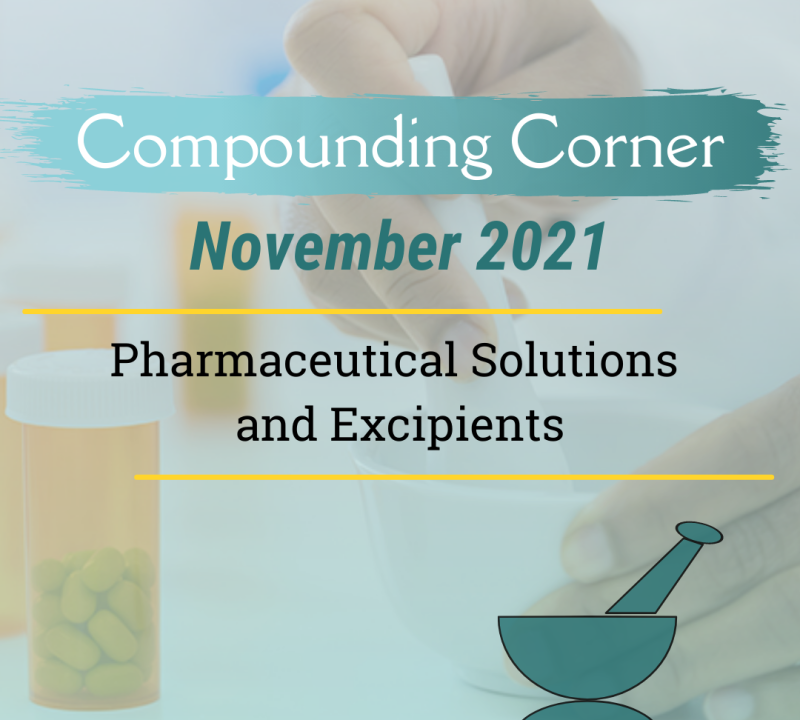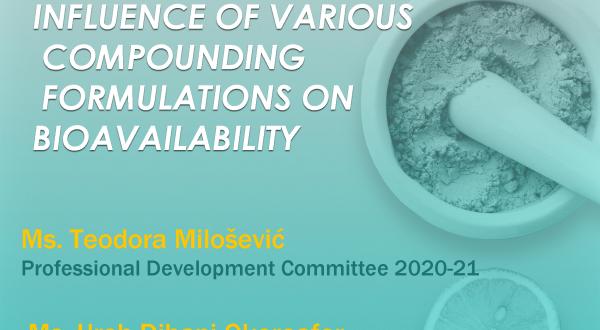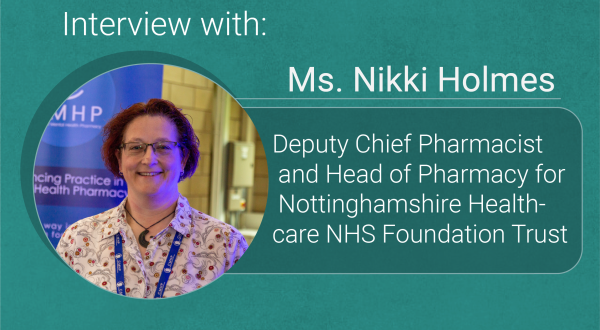
PHARMACEUTICAL SOLUTIONS AND EXCIPIENTS
by Huyen T. M. Vo, Natania Rahardja, YeJin Kim, and Zhinya Kawa
IPSF Professional Development Interns 2020-21
1. Pharmaceutical Solution.
A. What is a Pharmaceutical Solution?
A solution is a homogeneous liquid preparation that contains one or more dissolved medications. Since, by definition, active ingredients are dissolved within the vehicle, uniform doses by volume may be obtained without any need to shake the formulation.
Owing to the simplicity and hence the speed of preparation of an ad hoc formulation, they are of particular use for individuals who have difficulty in swallowing solid dosage forms, i.e. pediatric, geriatric, intensive care and psychiatric patients, where compliance needs to be checked on administration, and in cases where precise, individualized dosages are required (Langley & Blecher, 2012).
B. Drug solubility
The following points relating to the solubility of the drug element(s) of the formulation need to be taken into consideration:
- Will the drug(s) dissolve in the solvent or a component of the solvent system?
- What quantity of drug will dissolve?
- How long will dissolution take?
- Will the drug(s) remain in solution and for how long?
- What is the pH of solvent required for dissolution?
When preparing a solution, the solid(s) will need to go through a dissolution phase. During compounding, it is worth remembering that dissolution rates generally increase with:
- smaller particle sizes
- effective stirring
- lower viscosities
- increased temperature
(Marriott et al., 2010)
2. What is a Pharmaceutical Excipient?
The word ‘excipient’ is derived from the Latin excipere, meaning ‘to except’, which is simply explained as ‘other than’. Nowadays, medicines are available in many dosage forms including tablets, capsules, oral liquids, topical creams and gels, transdermal patches, injectable products, implants, eye products, nasal products, inhalers, and suppositories. Pharmaceutical excipients are the additives that are added to the formulation along with pharmacologically active substances. The main purpose of adding them is to increase the bulk of the formulation along with imparting desired properties and as substances that are other than the pharmacologically active drug or prodrug, which are included in the manufacturing process or are contained in a finished pharmaceutical product dosage form, to aid the manufacturing process, to protect, support or enhance stability, or for bioavailability or patient acceptability and they have been appropriately evaluated for safety and are intentionally included in a drug delivery system. They may be important for keeping the drug from being released too early in the assimilation process in places where it could damage tender tissue and create gastric irritation or stomach upset. Although assisting in product identification and enhancing the overall safety or function of the product during storage also assists in the effectiveness and/or delivery of the drug in use. Ideal properties of excipients include “Stable for handling, feasible, cost effectiveness, desired functionality, no unwished interaction with drugs and pharmacologically inert” (Haywood & Glass, 2011).
Classification of the excipients is based on their role in the pharmaceutical formulation and on their interactions influencing drug delivery, based on their chemical and physico-chemical properties. The main classes are the antioxidants, coating materials, emulgents, taste- and smell-improvers, ointment bases, conserving agents, consistency-improvers and disintegrating materials. Some of the excipients may serve multiple purposes; for example, methylcellulose, a coating material, is applied in the preparation of suspensions, to increase viscosity, as a disintegrating agent or binder in tablets (Kalász & Antal, 2006). Other examples include calcium phosphates, artificial sweeteners, cellulose ether, glycerin, fillers and diluents, flavouring agents, binder, etc.
3. Types of excipients used in the formulation of pharmaceutical solutions
A. Agents that enhance the solubility of the therapeutic agent in the vehicle
Pharmaceutical solutions contain a range of excipients, each with a defined pharmaceutical purpose. Examples include:
- The vehicle, usually purified water
- Co-solvents, e.g. propylene glycol, glycerin, alcohol
- Surface-active agents specifically to enhance solubility of the therapeutic agent in the vehicle.
- Preservatives, e.g. parahydroxybenzoate esters (methylhydroxybenzoate and propylhydroxybenzoate), boric acid and borate salts, sorbic acid and sorbate salts.
- Sweeteners, e.g. glucose, saccharin, aspartame
- Rheology (viscosity) modifiers, e.g. hydrophilic polymers (cellulose derivatives, alginic acid, polyvinylpyrrolidone)
- Antioxidants, e.g. sodium formaldehyde sulphoxylate, butylated hydroxyanisole, butylated hydroxytoluene
- Buffers to regulate the pH of the formulation, e.g. citrate buffer.
(Jones, 2016).
B. Vehicle (usually purified water)
In liquid pharmaceutical formulations, vehicles are major components used as a base in which drugs and other excipients are dissolved or dispersed. They function by breaking bonds and reducing effective charge on ions, thus increasing solute-solvent forces of attraction which are eventually greater than solute-solute and solvent-solvent forces of attraction (Pharmapproach, 2020).
Water is a key ingredient used in many pharmaceutical and life sciences operations and extensively used as a raw material, ingredient, and solvent in the processing, formulation, and manufacture of pharmaceutical products, active pharmaceutical ingredients (APIs) and intermediates. Purified water is water that has been filtered or processed to remove impurities like chemicals and other contaminants and also used as an excipient in the production of non-parenteral preparations and in other pharmaceutical applications, such as cleaning of certain equipment and non-parenteral product-contact components.
Water used in the production of drug substances or as a source or feed water for the preparation of the various types of purified waters must meet the requirements of the National Primary Drinking Water Regulations (NPDWR) (40 CFR 141) issued by the U.S. Environmental Protection Agency (EPA) or the drinking water regulations of the European Union or Japan, or the WHO drinking water guidelines.
Purified water is commonly produced by ion exchange, reverse osmosis (RO), ultrafiltration or electro- deionization processes and distillation.
It is essential to consider the mechanisms for microbiological control and sanitization.
- Control of temperature in the system by heat exchanger or plant room cooling to reduce the risk of microbial growth (guidance value < 25 °C).
- Provision of ultraviolet disinfection.
- Application of chemical sanitization (including agents such as ozone, hydrogen peroxide and/or peracetic acid); thermal sanitization at > 65 °C.
(Shukshith & Gupta, 2016).
C. Co-solvents
Cosolvents are a substance that is added to a mixture of two or more separate substances that are typically immiscible, in order to make them mixable also commonly used to modify the concentration gradient at the meniscus front, which can enable more continuous and larger crystalline domains than what can be obtained from the coating of single-solvent-inks. Cosolvents that are most used are methanol, ethanol and water. The effectiveness of a cosolvent is determined by its solubilization power. This is the maximum rate of dissolution of a solute in mixtures of various compositions. Cosolvents work best in the presence of another solvent that, in conjunction, enhances the dissolution of a solute.
Cosolvent system works by reducing the interfacial tension between the aqueous solution and hydrophobic solute. It is also commonly referred to as solvent blending. Most cosolvents have hydrogen bond donor and/or acceptor groups as well as small hydrocarbon regions. Their hydrophilic hydrogen-bonding groups ensure water miscibility, while their hydrophobic hydrocarbon regions interfere with water's hydrogen bonding network, reducing the overall intermolecular attraction of water. By disrupting water self-association, cosolvents reduce water's ability to squeeze out nonpolar, hydrophobic compounds, thus increasing solubility. The advantage of cosolvent technology enhancing drug solubility in a liquid-based formulation includes convenience, removing the need for mixing solvent before administration; safety, avoiding contamination in the dispensing process; inexpensive, no need for expensive pharmaceutical technology for formulation of dosage form (Nayak & Panigrahi, 2012).
D. Rheology modifier
These are excipients that minimize inter-particle attraction and aggregation by functioning as an energy barrier thus retarding particle settling. The selection of an appropriate suspending agent is one of the most crucial factors in formulating a pharmaceutical suspension.
The factors considered in the selection of the appropriate suspending or viscosity enhancing agents include desired rheological property, suspending ability in the system, pH stability, chemical compatibility with drug substance and other excipients, reproducibility, hydration time, and cost (Pharmapproach, 2020).
E. Preservatives
The official compendia states that suitable substances may be added to an official preparation to enhance its permanency or usefulness. Such additives are suitable only if they are nontoxic and harmless in the amounts administered and do not interfere with the therapeutic efficacy or tests or assays of the preparation. These substances called “preservatives'' give assurance of shelf-life and preservation against microbial contamination. Preservatives are thought to interfere with microbial growth, multiplication, and metabolism.
There are some preparations such as elixirs, spirits, and tinctures that are self-sterilizing and do not require additional preservation. The same applies to other pharmaceuticals which by virtue of their vehicles or other formulating agents, including the main therapeutic agent, may not permit the growth of microorganisms.
When experience and shelf – storage experiments indicate that a preservative is required, its selection is based on the following:
- The preservative is effective in preventing the growth of the type of microorganisms considered the most likely contaminants of the preparation being formulated.
- The preservative is soluble enough in water to achieve adequate concentrations in the aqueous phase of a two or more phase system (its partition coefficient).
- The proportion of preservative remaining undissociated at the pH of the preparation makes it capable of penetrating the microorganism and destroying its integrity.
- The required concentration of the preservative does not affect the safety or comfort of the patient when the pharmaceutical preparation is administered by the usual or intended route.
- The preservative has adequate stability and will not be reduced in concentration due to chemical decomposition or volatilization during the desired shelf life of the preparation.
- The preservative is completely compatible with all other formulating ingredients and does not interfere with them, nor do they interfere with the effectiveness of the preservative agent.
- The preservative should not adversely affect the preparation container or the closure.
(Allen, 2014)
F. Buffers
These are materials which, when dissolved in a solvent, enables it to resist any change in pH when an acid or an alkali is added. The choice of a suitable buffer depends on the pH and buffering capacity required. It must be compatible with other excipients and have low toxicity. Most pharmaceutically acceptable buffering systems are based on carbonates, citrates, gluconates, lactates, phosphates or tartrates. As the pH of most body fluids is 7.4, products such as injections, eye drops and nasal drops, should in theory, be buffered at this value (Nanjwade, 2014).
Stabilizers are substances which inhibit the reaction between two or more chemicals. They may be considered as substances that inhibit the separation of emulsions, suspensions and foams. They may be thought of as the opposite of catalysts in function. Antioxidants, sequestrants, surface active agents, and emulsifiers have stabilizing properties and they ensure stability during the shelf life of the products in which they are added .
G. Flavoring, Sweetening and Colouring Agents
- Flavoring Agents
Certain flavouring materials have been found through experience to be more effective than others in masking or disguising the particular bitter, salty, sour or otherwise undesirable taste of medicinal agents. Although individuals’ tastes and flavour preferences differ, cocoa flavoured vehicles are considered effective for masking the taste of bitter drugs, fruit or citrus flavours are frequently used to combat sour or acid tasting drugs, and cinnamon, orange, raspberry, and other flavours have been successfully employed to make preparations of salty drugs more palatable.
The solubility of the flavouring agent in the vehicle selected for the preparation is the most important consideration as it affects the chemical stability of the flavorant in the presence of the other formulating ingredients. The age of the intended patient is also considered in the selection of a flavouring agent, for certain age groups seem to prefer certain flavours. For example, children prefer sweet candy like preparations with fruity flavours, but adults seem to prefer less sweet preparations with a tart rather than a fruit flavour, and geriatric patients may favour the refreshing taste of mint or of a tasty wine. Regardless of the flavor employed, the goals are the same, that is, to make the preparation more palatable for the patient (Onugha, 2011).
- Sweetening Agents
Sweetening agents are employed in liquid formulations designed for oral administration specifically to increase the palatability of the therapeutic agent. These agents may be obtained from natural or artificial sources (Jones, 2016).
Examples of sweetening agents from natural sources include
- Sucrose: Sucrose is soluble in water, colorless, stable at pH 4-8, and increases viscosity. Sucrose is arguably the best taste/mouthfeel overall but cariogenic and calorific and so should be avoided in pediatrics.
- Sorbitol: This is another example of natural sweetener. It is non-cariogenic and non-calorific. Sorbitol is appropriate for pediatric formulations, but lower sweetness intensity than sucrose. This means that more of it is usually added to the formulation and this can cause diarrhea.
(Pharmapproach, 2020).
The use of artificial sweetening agents in formulations is increasing and, in many formulations, saccharin sodium is used either as the sole sweetening agent or in combination with sugars or sorbitol to reduce the sugar concentration in the formulation. Other examples of artificial sweeteners in addition to saccharin and its salts are Aspartame, Acesulfame –K, and Sucralose (excellent sweetness, non-cariogenic, low calorie, wide & growing regulatory acceptability but relatively expensive). The use of sugars in oral formulations for diabetic patients and children should be avoided. (Jones, 2016)
- Colouring Agents
Once a suitable flavour has been chosen, it is often useful to include a colour which is associated with that flavour to improve the attractiveness of the product. Other reasons for the inclusion of colours are to enable easy product identification particularly of poisonous materials and to differentiate between the many types of solutions. It is essential to ensure that any colour chosen is acceptable in the country in which the product is to be sold and must not interfere with the stability of the product. As with flavouring agents, a wide range of colours are available in both natural and synthetic forms. Natural colours are more widely acceptable. They are, however, associated with problems like variations in availability and chemical compositions, both of which may cause formulation difficulties. Synthetic or ‘coal tar’ dyes are generally more stable than natural dyes but care must be taken to ensure that any dye chosen is not adversely affected by pH or U.V radiation or by the inclusion of oxidizing or reducing agents, or surfactants.
References:
Allen, L. (2014). Ansel’s Pharmaceutical Dosage Forms and Drug Delivery Systems. Lippincott Williams & Wilkins.
Haywood, A., & Glass, B. D. (2011). Pharmaceutical excipients – where do we begin? Australian Prescriber, 34. https://doi.org/10.18773/austprescr.2011.060
Jones, D. S. (2016). FASTtrack Pharmaceutics Dosage Form and Design, 2nd edition. Pharmaceutical Press.
Kalász, H., & Antal, I. (2006). Drug excipients. Current Medicinal Chemistry, 13(21), 2535–2563. https://doi.org/10.2174/092986706778201648
Langley, C. A., & Blecher, D. (2012). Chapter 2: Solution. In FASTtrack: Pharmaceutical Compounding and Dispensing (Second, p. 224). Pharmaceutical Press.
Marriott, J. F., Wilson, K. A., Langley, C. A., & Blecher, D. (2010). Pharmaceutical Compounding and Dispensing (2nd ed). Pharmaceutical press.
Nayak, A. K., & Panigrahi, P. P. (2012). Solubility Enhancement of Etoricoxib by Cosolvency Approach. ISRN Physical Chemistry, 2012, e820653. https://doi.org/10.5402/2012/820653
Nanjwade, Basavaraj K. N. (2014). Physicochemical Principles. Tobruk: Omer Al-Mukhatar University
Onugha, Ogochukwu N. C. (2011). The effect of preservatives on the aqueous stability of an oral rehydration salt solution. Nsukka: University Of Nigeria.
Pharmapproach. (2020). Excipients used in the formulation of liquid dosage forms. Pharmapproach.com. from https://www.pharmapproach.com/excipients-used-in-the-formulation-of-liquid-dosage-forms/.
Shukshith, K. S., & Gupta, N. V. (2016). Water for pharmaceutical use. International Journal of Pharmaceutical Sciences Review and Research, 36, 199–204.



